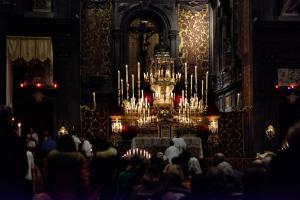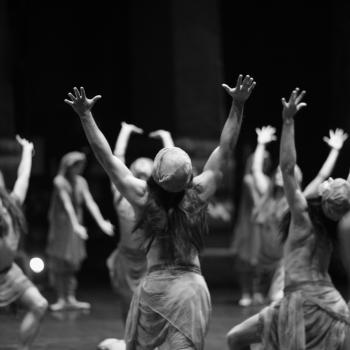 If you inhabit the modern world, you might be forgiven for not understanding ritual. For many moderns, in fact, the very word “ritual” evokes something dark and irrational — secret acts performed in darkness for nefarious ends. (Run a Google image search for “ritual” to see what I mean.) This popular association between ritual and spookiness, including occultism, is almost certainly the product of age-old anti-Catholic prejudices in English-speaking cultures. But even some Catholics get weirded out by ritual: in a surprise move, Pope Francis recently laid heavy new restrictions on the summit of Roman Catholic ritualism, the Tridentine Latin mass. From the viewpoint of cultural evolution, the resulting firestorm of controversy may help illuminate why so many people don’t believe what their churches teach.
If you inhabit the modern world, you might be forgiven for not understanding ritual. For many moderns, in fact, the very word “ritual” evokes something dark and irrational — secret acts performed in darkness for nefarious ends. (Run a Google image search for “ritual” to see what I mean.) This popular association between ritual and spookiness, including occultism, is almost certainly the product of age-old anti-Catholic prejudices in English-speaking cultures. But even some Catholics get weirded out by ritual: in a surprise move, Pope Francis recently laid heavy new restrictions on the summit of Roman Catholic ritualism, the Tridentine Latin mass. From the viewpoint of cultural evolution, the resulting firestorm of controversy may help illuminate why so many people don’t believe what their churches teach.
It’s a plain fact, after all, that many people ignore the standard doctrines of their religions. Take “Cafeteria Catholics,” who pick some Catholic teachings to believe while rejecting all the others. Officially, the Church teaches transubstantiation, the doctrine that the bread and wine of Communion literally become the real body and blood of Christ during mass. The Church also forbids contraception and expects all members to go to formal confession at least once a year. But in reality, only about one-third of American Catholics believe in transubstantiation. The overwhelming majority — around 90% — accept and use contraception, while only a quarter go to confession annually if at all.
But are today’s cafeteria Catholics really so noteworthy? My colleague Dimitris Xygalatas, an anthropologist at the University of Connecticut, has argued that they’re not, seeing them instead as merely just another illustration of the “religious congruence fallacy:” the questionable expectation that believers’ actions and beliefs match the doctrines of their faiths. For instance, Christian doctrine teaches that God exists outside of time and so can be everywhere at once. But in lab studies, professing Christians can’t help thinking of God as acting sequentially, focusing on one task at a time. Maybe cafeteria Catholicism is just another example of the normal “theological incorrectness” that we find in all religions.
The Midcentury Shift in Faith
However, there’s good reason to think that Catholics weren’t always quite as indifferent to Church teachings as they are today. Remember the old stereotype about big Catholic families? Well, there used to be something to it: in the mid-20th century, Catholic families were on average 20% larger than Protestant families. Not coincidentally, during this era only 30% of Catholics — and only around 22% of those who attended mass regularly — reported using birth control. The difference in size between Catholic and Protestant families suggests that Catholics weren’t lying about their avoidance of contraceptives.
However, obedience to Church teaching started to plummet soon afterward. By 1965, a full 44% of frequent attendees at mass had used birth control, compared with a remarkable 74% of Catholics who attended mass less frequently. By the 1980s, majorities of Catholics rejected belief in transubstantiation as well.
Church attendance by Catholics has followed similar trends. Gallup recently reported that
In 1955, practicing Catholics of all age groups largely complied with their faith’s weekly mass obligation. At that time, roughly three in four Catholics, regardless of their age, said they had attended church in the past week. This began to change in the 1960s, however, as young Catholics became increasingly less likely to attend. The decline accelerated through the 1970s and has since continued at a slower pace.
So what happened in the 1960s? Why did Catholics, who had previously been much more religiously strict than American Protestants, suddenly start selectively ignoring the teachings of their own faith?
This is an interesting question in the analysis of religion, and any good answer is sure to be complex. For one thing, modern life in general makes it difficult to believe in traditional religious beliefs. The sociologist Peter Berger called this process secularization, referring to the growth of many different, competing worldview options, which together gradually undermine the plausibility of any one religious worldview. In secularization, people might retain their old religious identities, without putting much stock in their doctrines or even attending services.
In America, this process has affected Catholicism just as much as other traditions. We might, then, credibly chalk up at least some of cafeteria Catholicism to secularization, plain and simple.
Vatican II as a Catalyst for Change
But significant changes to Catholic liturgy and practices also took place during that same time period. The Second Vatican Council, which concluded in 1965, aimed to improve ecumenical relationships between Roman Catholics and other Christians, while bringing the Church into closer harmony with the modern societies where its churches were lodged.
Among the most significant changes were that mass was no longer celebrated by default in the traditional Latin, but rather in vernacular languages such as English, Spanish, or Tagalog (the lingua franca of the Philippines). Catholic worship often became less ornate, with more focus on readings and sermons, and less on the ritualistic aspects of the service. Priests now faced the people rather than the altar. And the traditional Friday fast — when Catholics worldwide were long accustomed to abstaining from meat — was quietly deemphasized. Instead, many bishops and priests encouraged their flocks to do good works on Friday instead.
After Vatican II, the traditional mass in Latin disappeared from the vast majority of Catholic parishes, though a few idiosyncratic priests and arch-conservatives (who tended to, er, reject the new teachings quite strongly) carried on the old rite semi-licitly. But in 2008, the now-retired Pope Benedict announced a new allowance for priests to perform the old Latin mass. Parishes dedicated to the traditional rite started opening up, and enthusiasts began to gather. Many were no longer the old guard of reactionaries but younger Catholics with families. Adherents — even those weirded out by the conservative insularity of many Latin mass communities — claimed to love the solemnity, beauty, and mysteriousness of the Latin mass. In other words, they loved the ritualism.
Challenging the universal applicability of the religious congruence fallacy, Latin mass adherents are much, much more in line with the official teachings of the Church than other Catholics. In a 2018 survey of more than 1300 Catholic respondents, only 2% of those who attended Latin mass services claimed to approve of contraception, while a full 98% regularly went to confession. This probably wasn’t just empty posturing: the average number of children per woman was nearly 60% higher among Latin mass attendees than among regular mass attendees. Latin mass enthusiasts also overwhelmingly (99%) reported going to mass weekly, compared to only 22% of their counterparts.
Whether or not you agree with their highly conservative views, it seems clear that Latin mass attendees are, objectively, much more closely aligned with official Church teaching than most other Catholics are. Cafeteria Catholics they’re not. Why would this be?
Latin Mass as a Credibility-Enhancing Display
It might not be so surprising that super-ritualistic worship might coincide with firm adherence to official teachings. The anthropologist Joseph Henrich has argued that many religious rituals serve as Credibility-Enhancing Displays (CREDs), which lead people to assign a higher probability to cultural claims that can’t easily be empirically validated. Henrich illustrates this principle with an unusual example: poisonous mushrooms. Let’s say that you’re too young or inexperienced to know which mushrooms are poisonous and which are tasty. If an elder in your tribe claims “these little blue mushrooms are good to eat,” you’d be wise to be skeptical — unless he eats them himself. You only believe him when he puts his money where his mouth is.*
Similarly, rituals can serve to show that performers really believe in the strange claims of their faiths. Take the doctrine of transubstantiation. Behind all the archaic Aristotelian terminology, this doctrine simply proposes the more primary and religiously important idea that God is somehow really “present” in the Eucharist (the consecrated bread and wine) in a condensed, special way. Sure, God is “present” everywhere and in all things, but in some mysterious way he’s particularly present in the Eucharist.
If you really believed this, then you’d probably be inclined to treat Communion with reverence. Conspicuous reverence. By contrast, if you thought that the doctrine of the Real Presence was just a metaphor or a symbolic way of speaking, you might treat the ceremony more lightly. Accordingly, many Protestant denominations put on much less ornate Communion services than Catholics traditionally did, since most Protestant denominations explicitly teach that God is not actually “present” in the bread and wine. Instead, Communion is just a symbolic memorial, not a material incarnation.
But although modern Catholicism still officially teaches the doctrine of the Real Presence, its newer rituals are often reminiscent of Protestantism in form. For example, the modern mass emphasizes the verbal, rational communication of ideas (hence the use of the vernacular) and ethics more, and formalized actions and taboos less, than the old rite typically did. Of course, we’re talking about a spectrum: Catholicism is still, well, Catholic. It’s just not quite as exotic, from a Protestant point of view, as it once was.
However, in some important ways this state of affairs presents a mismatch between what Catholicism explicitly teaches and what its rituals implicitly teach. It’s possible that the weekly mass has become a poor CRED, or a CRUD — “Credibility-Undermining Display” — for the doctrine of transubstantiation. After all, if Catholic priests actually believed that Christ was really, literally present in the bread and wine, wouldn’t they treat the Eucharist like something that was charged, even dangerous? Two generations of Catholics have now grown up attending masses that sometimes seem, in nonverbal ways, to send the message that the Eucharist is just a symbol after all. It’s not surprising that most of them have come to believe what the ritual implies rather than what the doctrine teaches. This is just “actions speak louder than words” applied to religion.
By contrast, Latin mass ceremonies are famously ornate, filled with gravitas, and even nakedly anachronistic. The music is typically Gregorian chant rather than guitar-driven praise music. Thick clouds of incense billow away into the rafters. And the priest makes a big deal of the consecration.
It’s all a bit more compatible, in a CREDs-like way, with the doctrine that God is making an in-person appearance. Participants observing the proceedings may be more likely to implicitly judge that the priest really believes in the Real Presence. And if he does, why shouldn’t they, too? In this way, the Latin mass might just be an exceptionally strong CRED.
Costly Signaling and Selection Effects
At the same time, we can’t ignore selection effects — conservative Catholics might be self-selecting into Latin mass parishes, helping explaining the unique profile of those communities. That is, it might not be that Latin mass is creating more people who believe in official Catholic teachings. Rather, the small minority of Catholics who do believe the teachings might simply be migrating to the Latin mass, creating a doctrinally and ritually unique subcultural space within the broader Church.
But in social phenomena, causation is rarely linear. Things happen in feedback loops. So while it’s undoubtedly true that Catholic traditionalists are more likely than others to start attending the Latin mass, Latin mass parishes are also places where conservative beliefs are normative and expectations are strict. If you didn’t dress conservatively or go to confession regularly, you’d stick out like a sore thumb. If you weren’t already theologically conservative when you started attending, you’d likely either eventually become more conservative or drift back out the door.
In this way, Latin mass parishes are examples of costly signaling in ritual. Barriers to entry are high. Rituals are time-consuming and demanding. As I’ve written here before, costly signaling may explain why more demanding religious groups tend to grow more rapidly than less-strict groups. By ensuring that only the most committed want to join, costly communities maintain a higher average level of investment. Members are therefore more likely to stay within the fold, which offers a high concentration of CREDs — actions taken by others, especially those in authority, that indicate strong belief. The cultural world becomes strongly self-reinforcing.
Anti-Ritualism and Religious Cleansing
The Latin mass crowd is controversial, not least because it attracts some serious cranks. It’s so controversial, in fact, that the Pope himself just made it much harder to celebrate the Latin mass, requiring every priest who wants to say it to get his bishop’s explicit permission, while banning the Latin mass from parish church buildings. Pope Francis is an ardent defender of the Vatican II reforms, and likely sees the growth of the Latin mass’s popularity as a threat to that reforming vision.
Which, of course, it is. The Vatican II reforms were in many ways a quintessential example of anti-ritualism in religion. Anti-ritualism as an ideological theme appears again and again in the history of religions, taking a few reliable forms. It emphasizes the explicit and verbal rather than the implicit and enactive; it prioritizes universal ethics rather than particularistic rules and taboos; it highlights the individual over the communal; and it often expresses hostility to images and icons.
The Protestant Reformation was the paradigmatic example of anti-ritualism in Christianity, but it wasn’t alone in history. In the 8th and 9th centuries, outbreaks of iconoclasm broke out in the Byzantine Empire, leading to the wholesale destruction of Eastern Orthodox icons and statues across the eastern Mediterranean. In India, the advent of Buddhism in the 4th century BCE was an expression of anti-ritualism in reaction to the excesses of Vedic Hinduism. Wahhabism is an exceptionally anti-ritualistic strain of modern Islam. And in our era, Vatican II was the product of an anti-ritualistic strain within Catholicism.
The underlying impulse behind anti-ritualism is one of cleansing. Religious traditions inevitably build up hierarchies, rituals, accretions over time. Reformers come along and try to reduce things back to their basics, re-focusing the tradition on the essential teachings of the faith. Those teachings are necessarily verbal, so the reforming spirit is highly focused on explicit, discursive communication, but suspicious of the context-rich, implicit messaging found in ritual. Breaking up images, as in iconoclasm, aims to free the mind from accrued, unnecessary traditions, re-focusing it instead on immaterial, spiritual principles. (The same impetus also helps explain Protestants’ decision to change Communion from a material incarnation of God into a symbolic — that is, immaterial and spiritual — memorial.)
But ritual is also often the best tool for sending clear messages about extra-empirical claims, for showing others than one really believes in them. CREDs require actions, not words. Ergo, no religion can do without ritual in the long run.
In the meanwhile, the strange saga of the Latin mass adds a new layer of complexity to the religious congruence fallacy. It’s true that many, probably most, religious believers don’t believe or act the way their traditions officially tell them to. But there are some contexts — high-CRED contexts, we’ll call them — where this rule seems muted, even disconfirmed. Regardless how out-of-touch the beliefs of people in high-CRED contexts might seem, paying close attention to them offers crucial insight into how religion and culture work across time.
_______
*Incidentally, nearly this exact scenario just happened to me. The recent drought in California apparently being due to Massachusetts hogging all the rain in North America, lots of mushrooms have sprung up around my neighborhood. Last week, my next-door neighbor walked up and enthusiastically offered me a vibrantly colored, foraged wild mushroom called “chicken of the woods.” Seeing that he had eaten a hefty serving of it the day before and was still walking around looking hearty, I took him at his word that it was safe, and sautéd up the fungus with butter. It tasted great. So far, I have not died. Let’s hear it for CREDs!












